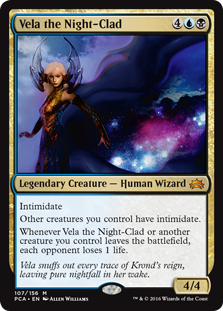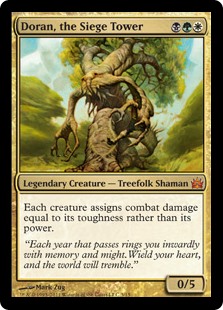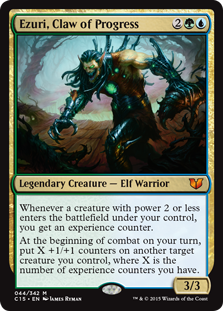Uncompetitive Spirit — Planechase EDH, part 1

Happy Holidays everyone! Hopefully you have some time off from school or work, and that you use this time off for some epic games of EDH with friends and family. Today, Uncompetitive Spirit brings you another way to mix things up - and make them games even more epic! I'm talking about mixing in another one of Magic's casual products: Planechase.
What is Planechase?

Planechase is a multiplayer variant that was released in two separate editions in 2009 and 2012 respectively, these are often dubbed Planechase and Planechase 2012 for obvious reasons. Each release each consisted of four pre-constructed decks, intended for multiplayer games, coupled with ten-card planar decks. These planar decks are the real stars of the release—the cards are all over-sized (twice the size of a regular Magic card), and they all feature brand new often quite spectacular artwork depicting both known and unknown worlds of the game. The 2012 edition of the pre-constructed decks are notable for consisting the first printing of such EDH staples such as Baleful Strix, Vela the Night-Clad, Maelstrom Wanderer, and Etherium-Horn Sorcerer. The 2012 planar decks also contain a new version of the planar cards, known as "phenomenon".
Each of the pre-constructed decks had its own planar deck, along with a planar die. These dice are six-sided dice with four blank faces, a symbol representing planeswalking (the now quite famous five-pronged Magic symbol), as well as a symbol representing "chaos". These dice are used to play the game, I'll explain the details below.
In 2016, the decks from Planechase 2012 along with all of the planar cards from both previous releases, along with six promotional planar cards (for a grand total of 86) were released under the name Planechase Anthology. If you're looking to get into this, I suggest you try and get your hands on this release.
Planechase in EDH (our way is the right way)
I will be up-front with two things right off the bat: First, mixing this with your regular EDH games will often not make for a quick and easy game of EDH - though they can speed things up considerably at times. Second, these cards are often very powerful, on the verge of being broken. The former downside is hard to do anything about, but the latter can be mitigated via implementing a different set of rules rather than the regular Planechase rules. The official rules, by the way, can be found on the mothership via following this link: CLICK.
However, to prevent the game from going haywire when someone flips the correct plane, here's how we play, and this is the way I recommend playing:
- Instead of everyone playing with their own planar deck, the table has a shared planar deck which everyone plays with.
- Any instances of "you" or "your" on the planar cards refers to the active player. For example, if a card has an effect which reads "At the beginning of your upkeep, draw a card", it would trigger in every player's upkeep.
- At the time start of the game, everyone reveals their commanders, shuffles their decks and so on as usual. The planar deck is shuffled as well and placed in the middle of the table (or somewhere where all players easily can see the cards). Then players roll for first turn, and decide on their openers. After this is done, the player who will take the first turn flips the top card of the planar deck. This is the starting plane.
- A player may roll the planar die at any time during his or her turn when he or she could cast a sorcery (i.e. the stack needs to be empty, and it needs to be during a main phase). This does not count as casting a spell or activating an ability of a permanent.
- If a player rolls the planeswalking symbol, he or she discards the active plane and flips over the next card. This sometimes triggers abilities of the new plane, which are resolved and then the player continues his or her turn.
- If a player rolls the chaos symbol, he or she triggers the plane's specific chaos ability, resolves it, and then continues as normal.
- Each of these abilities uses the stack, and may thus be responded to. So for example, if a player rolls the planeswalking symbol, each player may respond to this as normal before it resolves and the plane is changed.
- The first roll of the planar die every turn is free, then it costs one more generic mana for each time it has been rolled (0, 1, 2, 3, ...). The die may be rolled as many times as a player chooses, provided the player in question can pay for the activation.
- Phenomenon cards are resolved as soon as they are revealed, and the player who revealed it discards it immediately after that's done. After that, the player flips over the next planar card. Some phenomenon stays in play, it's clear if they do.
Seems simple, enough, right?
Why play Planechase EDH
The simple answer to this question is the same as for everything we do in EDH: because it's fun! The planar cards adds another layer of variance, and while this is both constructive and enjoyable for most, there are those who will find this variant infuriating. It makes for some very flavorful Magic any day of the week - we are supposed to be dueling planeswalkers after all, and it creates spectacles that etches into your memory; that game where someone kept a seven-lander as his opening, flipped Naya as the first plane, and then drew Tezzeret the Seeker in his first draw step, or that game when Naar Isle almost killed someone and we just couldn't planeswalk away.
What planes to play

As previously stated, I can't recommend everyone building their own planes deck and play that together with their EDH deck. The reason for this is two-fold: first, the cards are in many cases very powerful and it might break the game open if they are combined with the proper cards. Second, the cards are quite scarce - it's unlikely that more than just a couple of people in any given play group have any planes cards at all. In my playgroup, we play with all 86 cards with no selection, but if you want to tool the shared planes deck, I would break it down like this: the planes can be separated into categories, and it could be done like this:
- Constructive planes: These are planes that progress the game forward in some form. This can be done in a number of ways: make creatures bigger, making players draw more cards, allowing more lands drops, making players lose life. (for example: Krosa allows creatures to deal more combat damage and speeds up the game.)
- Destructive planes: These are planes that hinder the game from progressing forward, or moves the board states backwards and makes for a longer game. This can also be done in a number of different ways: by forcing players to discard cards, by destroying creatures or other permanents, by shrinking creatures, by countering spells, etc. (for example: Sanctum of Serra will wipe the board, Kessig will fog any non-Werewolf creatures).
- Mixed planes: These progress the game in some aspect and hinder it in another (for example: Hedron Fields of Agadeem likely prevents at least some creature from attacking or blocking, but the chaos ability adds more power to the board for the eventual planeswalk, and and since it prevents blocking by large creatures it may open up some lanes of attack).
- Utility planes: Other planes that neither progress nor hinder the game in most instances (for example The Great Forest might be a great flip if you're rocking your Doran, the Siege Tower deck, but it's unlikely to do much in most instances unless you get lucky and hit the chaos sylbol).
I've taken the liberty to break down every plane in the set into these categories, in order to help you make a proper selection. If you want a planar deck that will make for somewhat quicker games, make sure to add more planes from the Constrictive planes list, if you're looking for a chaotic game, you can add as much as you want from the Destructive planes list. Note that I am mostly looking at the static ability or the main triggered ability of the plane card in question, less so the chaos ability. These do tend to synergize, though not always.
|
|
As is evident from the lists above, there are way more of the constrictive planes than the other, though some of them only affect some players. When making your planes deck, make sure you be careful with the stuff in the destructive planes category as these will cause set backs at the table and most of them will actively make the games longer.
Looking forward!
Planechase EDH is so epic, it's not enough to write just one article about it - next time I'm going to go over some of the strategies you can employ when playing with these awesome cards. I will say this though: the games are for most of the time the most enjoyable if people stick to decks that want to beat down with creatures. I'm not saying everyone has to go full wide aggro, but decks that play creatures and interact with creatures in some way make the most out of most of the planes, and as such will both fare better and be more fun to pilot in the variant. Next week I will also throw a commander into the Uncompetitive Arena and see how that particular commander would fare in a game of Planechase EDH, by using the "View average deck" feature of this very site. I won't post the decklist today, but the commander will be this fellow:

Until next time, stay awesome and keep it casual!
EDHREC Code of Conduct